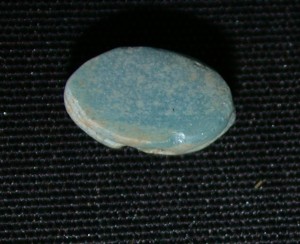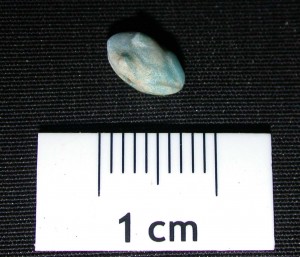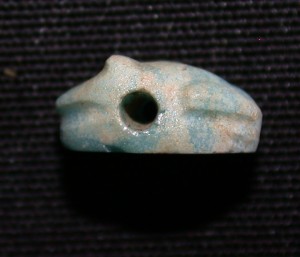A very small faience object delighted us this week: a nicely done, really tiny (only 8 mm in lenght!) amulet in the form of a squatting frog with open mouth came up while cleaning around feature 28, the Post-New Kingdom stone foundation in Square 2b. It is in fact an uninscribed frog amulet or scaraboid as the flat, oval base was left uncarved.
The amulet was obviously once used on a string – whether on a necklace or a bracelet remains open – it has a regular perforation at its lateral side, piercing the amulet in the centre, not longitudinally. Unfortunately, the archaeological context – found in dense mud debris with mixed ceramic material, filling material of the depression south of feature 28 – does not provide any glue for dating.
 In Ancient Egypt, frogs were primarily associated with fecundity, (female) fertility and birth – they are common amulets used during a long time span, both for the living and in funerary contexts. Beads in the form of frogs are also well known from New Kingdom domestic contexts – for example in Egypt in Amarna (see Anna Stevens 2006. Private religion at Amarna, pp. 56-57) – however, the frogs there differ in shape and have a characteristic upraised head. Very small frog pendants or amulets are reported from Eighteenth Dynasty votive contexts in Egypt – these I will have to check back home with a proper library! It would of course be tempting to connect SAV1E 294 with the temple area in the Pharaonic town of Sai! But as amulets in form of frogs survived well beyond the New Kingdom, until the Ptolemaic time and were also common in later phases of Nubian cultures (e.g. in Napatan tombs), I definitely want to deepen the search for parallels before our small frog from SAV1E can be tentatively dated by analogies! Regardless of its date, it is a very nice artefact and one of this season’s favorites!
In Ancient Egypt, frogs were primarily associated with fecundity, (female) fertility and birth – they are common amulets used during a long time span, both for the living and in funerary contexts. Beads in the form of frogs are also well known from New Kingdom domestic contexts – for example in Egypt in Amarna (see Anna Stevens 2006. Private religion at Amarna, pp. 56-57) – however, the frogs there differ in shape and have a characteristic upraised head. Very small frog pendants or amulets are reported from Eighteenth Dynasty votive contexts in Egypt – these I will have to check back home with a proper library! It would of course be tempting to connect SAV1E 294 with the temple area in the Pharaonic town of Sai! But as amulets in form of frogs survived well beyond the New Kingdom, until the Ptolemaic time and were also common in later phases of Nubian cultures (e.g. in Napatan tombs), I definitely want to deepen the search for parallels before our small frog from SAV1E can be tentatively dated by analogies! Regardless of its date, it is a very nice artefact and one of this season’s favorites!


